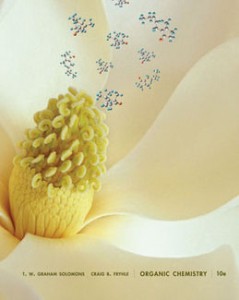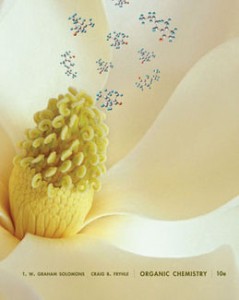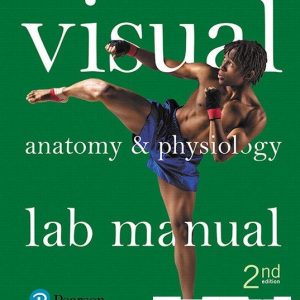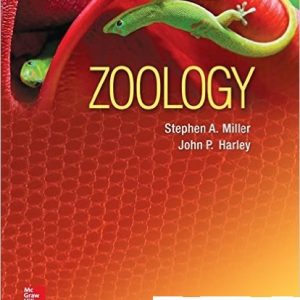This is completed downloadable of Test Bank for Organic Chemistry, 10th Edition: Solomons

Product Details:
- ISBN-10 : 0470401419
- ISBN-13 : 978-0470401415
- Author:
The Tenth Edition of Organic Chemistry continues Solomons/Fryhle’s tradition of excellence in teaching and preparing students for success in the organic classroom and beyond. In the Tenth Edition, virtually every aspect of the teaching and learning solution has been revisited and redesigned to assist students in comprehending the fundamentals of organic chemistry. The authors’ thoroughly explain and illustrate each new idea when it is first introduced and then reinforce the new idea or concept by having students work related problems.
Table of Content:
1 THE BASICS: Bonding and Molecular Structure 1 1.1 We Are Stardust 2
1.2 Atomic Structure 2
1.3 The Structural Theory of Organic Chemistry 5
1.4 Chemical Bonds: The Octet Rule 7
1.5 How to Write Lewis Structures 9
1.6 Exceptions to the Octet Rule 11
1.7 Formal Charges and How to Calculate Them 13
1.8 Resonance Theory 15
1.9 Quantum Mechanics and Atomic Structure 20
1.10 Atomic Orbitals and Electron Configuration 21
1.11 Molecular Orbitals 23
1.12 The Structure of Methane and Ethane: sp3 Hybridization 25
THE CHEMISTRY OF . . . Calculated Molecular Models: Electron Density Surfaces 29
1.13 The Structure of Ethene (Ethylene): sp2 Hybridization 30
1.14 The Structure of Ethyne (Acetylene): sp Hybridization 34
1.15 A Summary of Important Concepts that Come from Quantum Mechanics 36
1.16 Molecular Geometry: The Valence Shell Electron Pair Repulsion Model 38
1.17 How to Interpret and Write Structural Formulas 41
1.18 Applications of Basic Principles 46
2 FAMILIES OF CARBON COMPOUNDS: Functional Groups, Intermolecular Forces, and Infrared (IR) Spectroscopy 53
2.1 Hydrocarbons: Representative Alkanes, Alkenes, Alkynes, and Aromatic Compounds 54
2.2 Polar Covalent Bonds 57
THE CHEMISTRY OF . . . Calculated Molecular Models: Maps of Electrostatic Potential 59
2.3 Polar and Nonpolar Molecules 60
2.4 Functional Groups 62
2.5 Alkyl Halides or Haloalkanes 64
2.6 Alcohols 65
2.7 Ethers 67
THE CHEMISTRY OF . . . Ethers as General Anesthetics 67
2.8 Amines 68
2.9 Aldehydes and Ketones 69
2.10 Carboxylic Acids, Esters, and Amides 70
2.11 Nitriles 72
2.12 Summary of Important Families of Organic Compounds 72
2.13 Physical Properties and Molecular Structure 73
THE CHEMISTRY OF . . . Fluorocarbons and Teflon 78
2.14 Summary of Attractive Electric Forces 82
THE CHEMISTRY OF . . . Organic Templates Engineered to Mimic Bone Growth 82
2.15 Infrared Spectroscopy: An Instrumental Method for Detecting Functional Groups 83
2.16 Interpreting IR Spectra 87
2.17 Applications of Basic Principles 92
3 AN INTRODUCTION TO ORGANIC REACTIONS AND THEIR MECHANISMS: Acids and Bases 98
3.1 Reactions and Their Mechanisms 99
3.2 Acid-Base Reactions 101
3.3 Lewis Acids and Bases 102
3.4 Heterolysis of Bonds to Carbon: Carbocations and Carbanions 104
THE CHEMISTRY OF . . . HOMOs and LUMOs in Reactions 105
3.5 How to Use Curved Arrows in Illustrating Reactions 106
3.6 The Strength of Acids and Bases: Ka and pKa 109
3.7 How to Predict the Outcome of Acid-Base Reactions 113
3.8 Relationships between Structure and Acidity 115
3.9 Energy Changes 119
3.10 The Relationship between the Equilibrium Constant and the Standard Free-Energy
Change, ΔG° 120
3.11 The Acidity of Carboxylic Acids 121
3.12 The Effect of the Solvent on Acidity 125
3.13 Organic Compounds as Bases 126
3.14 A Mechanism for an Organic Reaction 127
THE CHEMISTRY OF . . . Carbonic Anhydrase
3.15 Acids and Bases in Nonaqueous Solutions 128
3.16 Acid-Base Reactions and the Synthesis of Deuterium- and Tritium-Labeled Compounds 130
3.17 Applications of Basic Principles 131
4 NOMENCLATURE AND CONFORMATIONS OF ALKANES AND CYCLOALKANES 137
4.1 Introduction to Alkanes and Cycloalkanes 138
THE CHEMISTRY OF . . . Petroleum Refining 139
4.2 Shapes of Alkanes 140
4.3 IUPAC Nomenclature of Alkanes, Alkyl Halides, and Alcohols 142
4.4 How to Name Cycloalkanes 149
4.5 Nomenclature of Alkenes and Cycloalkenes 151
4.6 Nomenclature of Alkynes 154
4.7 Physical Properties of Alkanes and Cycloalkanes 154
THE CHEMISTRY OF . . . Pheromones: Communication by Means of Chemicals 156
4.8 Sigma Bonds and Bond Rotation 157
4.9 Conformational Analysis of Butane 160
THE CHEMISTRY OF . . . Muscle Action 162
4.10 The Relative Stabilities of Cycloalkanes: Ring Strain 162
4.11 Conformations of Cyclohexane: The Chair and the Boat 163
THE CHEMISTRY OF . . . Nanoscale Motors and Molecular Switches 166
4.12 Substituted Cyclohexanes: Axial and Equatorial Hydrogen Atoms 167
4.13 Disubstituted Cycloalkanes: Cis-Trans Isomerism 171
4.14 Bicyclic and Polycyclic Alkanes 175
THE CHEMISTRY OF . . . Elemental Carbon 176
4.15 Chemical Reactions of Alkanes 177
4.16 Synthesis of Alkanes and Cycloalkanes 177
4.17 How to Gain Structural Information from Molecular Formulas and the Index of Hydrogen Deficiency 178
4.19 Applications of Basic Principles 181
5 STEREOCHEMISTRY: Chiral Molecules 186
5.1 Chirality and Stereochemistry 186
5.2 Isomerism: Constitutional Isomers and Stereoisomers 188
5.3 Enantiomers and Chiral Molecules 190
5.4 A Single Chirality Center Causes a Molecule to Be Chiral 191
THE CHEMISTRY OF . . .Life’s Molecular Handedness 193
5.5 More about the Biological Importance of Chirality 194
5.6 How to Test for Chirality: Planes of Symmetry 195
5.7 Naming Enantiomers: The R,S-System 196
5.8 Properties of Enantiomers: Optical Activity 201
5.9 The Origin of Optical Activity 205
5.10 The Synthesis of Chiral Molecules 207
5.11 Chiral Drugs 209
THE CHEMISTRY OF . . . Selective Binding of Drug Enantiomers to Left- and Right-Handed Coiled DNA 211
5.12 Molecules with More than One Chirality Center 211
5.13 Fischer Projection Formulas 215
5.14 Stereoisomerism of Cyclic Compounds 217
5.15 Relating Configurations through Reactions in Which No Bonds to the Chirality Center Are Broken 219
5.16 Separation of Enantiomers: Resolution 223
5.17 Compounds with Chirality Centers Other than Carbon 224
5.18 Chiral Molecules that Do Not Possess a Chirality Center 224
6 IONIC REACTIONS: Nucleophilic Substitution and Elimination Reactions of Alkyl Halides 230
6.1 Organic Halides 231
6.2 Nucleophilic Substitution Reactions 233
6.3 Nucleophiles 234
6.4 Leaving Groups 237
6.5 Kinetics of a Nucleophilic Substitution Reaction: An SN2 Reaction 237
6.6 A Mechanism for the SN2 Reaction 238
6.7 Transition State Theory: Free-Energy Diagrams 240
6.8 The Stereochemistry of SN2 Reactions 243
THE CHEMISTRY OF . . . Lysozyme
6.9 The Reaction of tert-Butyl Chloride with Hydroxide Ion: An SN1 Reaction 246
6.10 A Mechanism for the SN1 Reaction 247
6.11 Carbocations 248
6.12 The Stereochemistry of SN1 Reactions 251
6.13 Factors Affecting the Rates of SN1 and SN2 Reactions 254
6.14 Organic Synthesis: Functional Group Transformations Using SN2 Reactions 264
THE CHEMISTRY OF . . . Biological Methylation: A Biological Nucleophilic Substitution Reaction 266
6.15 Elimination Reactions of Alkyl Halides 268
6.16 The E2 Reaction 269
6.17 The E1 Reaction 271
6.18 How to Determine whether Substitutions or Elimination Is Favored 273
6.19 Overall Summary 276
7 ALKENES AND ALKYNES I: Properties and Synthesis. Elimination Reactions of Alkyl Halides 285
7.1 Introduction 286
7.2 The (E)-(Z) System for Designating Alkene Diastereomers 286
7.3 Relative Stabilities of Alkenes 288
7.4 Cycloalkenes 290
7.5 Synthesis of Alkenes via Elimination Reactions 291
7.6 Dehydrohalogenation of Alkyl Halides 291
7.7 Acid-Catalyzed Dehydration of Alcohols 297
7.8 Carbocation Stability and the Occurrence of Molecular Rearrangements 303
7.9 The Acidity of Terminal Alkynes 307
7.10 Synthesis of Alkynes by Elimination Reactions 308
7.11 Replacement of the Acetylenic Hydrogen Atom of Terminal Alkynes 310
7.12 Alkylation of Alkynide Anions: Some General Principles of Structure and Reactivity Illustrated 312
7.13 Hydrogenation of Alkenes 313
THE CHEMISTRY OF . . . Hydrogenation in the Food Industry 313
7.14 Hydrogenation: The Function of the Catalyst 314
7.15 Hydrogenation of Alkynes 315
7.16 An Introduction to Organic Synthesis 317
THE CHEMISTRY OF . . . From the Inorganic to the Organic 321
8 ALKENES AND ALKYNES II: Addition Reactions 331
8.1 Addition Reactions of Alkenes 332
8.2 Electrophilic Addition of Hydrogen Halides to Alkenes: Mechanism and Markovnikov’s Rule 334
8.3 Stereochemistry of the Ionic Addition to an Alkene 339
8.4 Addition of Sulfuric Acid to Alkenes 340
8.5 Addition of Water to Alkenes: Acid-Catalyzed Hydration 340
8.6 Alcohols from Alkenes through Oxymercuration-Demercuration: Markovnikov Addition 344
8.7 Alcohols from Alkenes through Hydroboration-Oxidation: Anti-Markovnikov Syn Hydration 347
8.8 Hydroboration: Synthesis of Alkylboranes 347
8.9 Oxidation and Hydrolysis of Alkyboranes 350
8.10 Summary of Alkene Hydration Methods 353
8.11 Protonolysis of Alkyboranes 353
8.12 Electrophilic Addition of Bromine and Chlorine to Alkenes 354
THE CHEMISTRY OF . . .The Sea: A Treasure of Biologically Active Natural Products 357
8.13 Stereospecific Reactions 358
8.14 Halohydrin Formation 359
8.15 Divalent Carbon Compounds: Carbenes 361
8.16 Oxidations of Alkenes: Syn 1,2-Dihydroxylation 363
THE CHEMISTRY OF . . . Catalytic Asymmetric Dihydroxylation 365
8.17 Oxidative Cleavage of Alkenes 365
8.18 Electrophilic Addition of Bromine and Chlorine to Alkynes 368
8.19 Addition of Hydrogen Halides to Alkynes 369
8.20 Oxidative Cleavage of Alkynes 370
8.21 How to Plan a Synthesis: Some Approaches and Examples 370
9 NUCLEAR MAGNETIC RESONANCE AND MASS SPECTROMETRY: Tools for Structure Determination 385
9.1 Introduction 386
9.2 Nuclear Magnetic Resonance (NMR) Spectroscopy 386
9.3 How to Interpret Proton NMR Spectra 392
9.4 Nuclear Spin: The Origin of the Signal 395
9.5 Detecting the Signal: Fourier Transform NMR Spectrometers 397
9.6 Shielding and Deshielding of Protons 399
9.7 The Chemical Shift 400
9.8 Chemical Shift Equivalent and Nonequivalent Protons 401
9.9 Signal Splitting: Spin-Spin Coupling 405
9.10 Proton NMR Spectra and Rate Processes 415
9.11 Carbon-13 NMR Spectroscopy 417
9.12 Two-Dimensional (2D) NMR Techniques 422
THE CHEMISTRY OF . . . Magnetic Resonance Imaging in Medicine 425
9.13 An Introduction to Mass Spectrometry 426
9.14 Formation of Ions: Electron Impact Ionization 427
9.15 Depicting the Molecular Ion 427
9.16 Fragmentation 428
9.17 How to Determine Molecular Formulas and Molecular Weights Using Mass Spectrometry 435
9.18 Mass Spectrometer Instrument Designs 440
9.19 GC/MS Analysis 442
9.20 Mass Spectrometry of Biomolecules 443
10 RADICAL REACTIONS 459
10.1 Introduction: How Radicals Form and How They React 460
10.2 Homolytic Bond Dissociation Energies (DH°) 461
10.3 The Reactions of Alkanes with Halogens 465
10.4 Chlorination of Methane: Mechanism of Reaction 467
10.5 Chlorination of Methane: Energy Changes 470
10.6 Halogenation of Higher Alkanes 477
10.7 The Geometry of Alkyl Radicals 480
10.8 Reactions that Generate Tetrahedral Chirality Centers 481
10.9 Radical Addition to Alkenes: The Anti-Markovnikov Addition of Hydrogen Bromide 484
10.10 Radical Polymerization of Alkenes: Chain-Growth Polymers 486
10.11 Other Important Radical Reactions 490
THE CHEMISTRY OF . . . Calicheamicin λ11: A Radical Device for Slicing the Backbone of DNA 492
THE CHEMISTRY OF . . . Antioxidants 494
THE CHEMISTRY OF . . . Ozone Depletion and Chlorofluorocarbons (CFCs) 495
11 ALCOHOLS AND ETHERS 502
11.1 Structure and Nomenclature 503
11.2 Physical Properties of Alcohols and Ethers 505
11.3 Important Alcohols and Ethers 507
THE CHEMISTRY OF . . . Ethanol as a Biofuel 508
11.4 Synthesis of Alcohols from Alkenes 508
11.5 Reactions of Alcohols 511
11.6 Alcohols as Acids 513
11.7 Conversion of Alcohols into Alkyl Halides 514
11.8 Alkyl Halides from the Reaction of Alcohols with Hydrogen Halides 514
11.9 Alkyl Halides from the Reaction of Alcohols with PBr3 or SOCl2 517
11.10 Tosylates, Mesylates, and Triflates: Leaving Group Derivatives of Alcohols 518
THE CHEMISTRY OF . . . Alkyl Phosphates 521
11.11 Synthesis of Ethers 522
11.12 Reactions of Ethers 527
11.13 Epoxides 528
THE CHEMISTRY OF . . . The Sharpless Asymmetric Epoxidation 529
11.14 Reactions of Epoxides 531
THE CHEMISTRY OF . . . Epoxides, Carcinogens, and Biological Oxidation 533
11.15 Anti 1,2-Dihydroxylation of Alkenes via Epoxides 535
THE CHEMISTRY OF . . . Environmentally Friendly Alkene Oxidation Methods 537
11.16 Crown Ethers 537
THE CHEMISTRY OF . . . Transport Antibiotics and Crown Ethers 539
11.17 Summary of Reactions of Alkenes, Alcohols, and Ethers 540
12 ALCOHOLS FROM CARBONYL COMPOUNDS: Oxidation-Reduction and Organometallic Compounds 548
12.1 Structure of the Carbonyl Group 549
12.2 Oxidation-Reduction Reactions in Organic Chemistry 550
12.3 Alcohols by Reduction of Carbonyl Compounds 552
THE CHEMISTRY OF . . . Alcohol Dehydrogenase – A Bioehcmical Hydride Reagent 554
THE CHEMISTRY OF . . . Stereoselective Reductions of Carbonyl Groups 555
12.4 Oxidation of Alcohols 557
12.5 Organometallic Compounds 561
12.6 Preparation of Organolithium and Organomagnesium Compounds 562
12.7 Reactions of Organolithium and Organomagnesium Compounds 563
12.8 Alcohols from Grignard Reagents 566
12.9 Protecting Groups 575
CONJUGATED UNSATURATED SYSTEMS 585
13.1 Introduction 586
13.2 Allylic Substitution and the Allyl Radical 586
THE CHEMISTRY OF . . . Allylic Bromination 590
13.3 The Stability of the Allyl Radical 590
13.4 The Allyl Cation 594
13.5 Resonance Theory Revisited 595
13.6 Alkadienes and Polyunsaturated Hydrocarbons 599
13.7 1,3-Butadiene: Electron Delocalization 600
13.8 The Stability of Conjugated Dienes 602
13.9 Ultraviolet-Visible Spectroscopy 604
THE CHEMISTRY OF . . . The Photochemistry of Vision 609
13.10 Electrophilic Attack on Conjugated Dienes: 1,4 Addition 612
13.11 The Diels-Alder Reaction: A 1,4-Cycloaddition Reaction of Dienes 616
THE CHEMISTRY OF . . . Molecules with the Nobel Prize in Their Synthetic Lineage 620
14 AROMATIC COMPOUNDS 632
14.1 The Discovery of Benzene 633
14.2 Nomenclature of Benzene Derivatives 634
14.3 Reactions of Benzene 637
14.4 The Kekulé Structure for Benzene 638
14.5 The Thermodynamic Stability of Benzene 639
14.6 Modern Theories of the Structure of Benzene 640
14.7 Hückel’s Rule: The 4n + 2 π Electron Rule 643
14.8 Other Aromatic Compounds 651
THE CHEMISTRY OF . . . Nanotubes 655
14.9 Heterocylic Aromatic Compounds 655
14.10 Aromatic Compounds in Biochemistry 657
14.11 Spectroscopy of Aromatic Compounds 660
THE CHEMISTRY OF . . . Sunscreens (Catching the Sun’s Rays and What Happens to Them) 664
15 REACTIONS OF AROMATIC COMPOUNDS 676
15.1 Electrophilic Aromatic Substitution Reactions 677
15.2 A General Mechanism for Electrophilic Aromatic Substitution 678
15.3 Halogenation of Benzene 680
15.4 Nitration of Benzene 681
15.5 Sulfonation of Benzene 682
15.6 Friedel-Crafts Alkylation 684
15.7 Friedel-Crafts Acylation 685
15.8 Limitations of Friedel-Crafts Reactions 687
15.9 Synthetic Applications of Friedel-Crafts Acylations: The Clemmensen Reduction 690
15.10 Substituents Can Affect Both the Reactivity of the Ring and the Orientation of the Incoming Group 691
15.11 How Substituents Affect Electrophilic Aromatic Substitution: A Closer Look 697
15.12 Reactions of the Side Chain of Alkylbenzenes 706
THE CHEMISTRY OF . . . Iodine Incorporation in Thyroxine Biosynthesis 707
THE CHEMISTRY OF . . . Industrial Styrene Synthesis 709
15.13 Alkenylbenzenes 712
15.14 Synthetic Applications 714
15.15 Allylic and Benzylic Halides in Nucleophilic Substitution Reactions 717
15.16 Reduction of Aromatic Compounds 719
16 ALDEHYDES AND KETONES: Nucleophilic Addition to the Carbonyl Group 729
16.1 Introduction 730
16.2 Nomenclature of Aldehydes and Ketones 730
16.3 Physical Properties 732
THE CHEMISTRY OF . . . Aldehydes and Ketones in Perfumes 733
16.4 Synthesis of Aldehydes 733
16.5 Synthesis of Ketones 738
16.6 Nucleophilic Addition to the Carbon-Oxygen Double Bond 741
16.7 The Addition of Alcohols: Hemiacetals and Acetals 744
16.8 The Addition of Primary and Secondary Amines 751
THE CHEMISTRY OF . . . A Very Versatile Vitamin, Pyridoxine (Vitamin B6) 753
16.9 The Addition of Hydrogen Cyanide: Cyanohydrins 755
16.10 The Addition of Ylides: The Wittig Reaction 757
16.11 Oxydation of Aldehydes 761
16.12 Chemical Analyses for Aldehydes and Ketones 761
16.13 Spectroscopic Properties of Aldehydes and Ketones 762
16.14 Summary of Aldehyde and Ketone Addition Reactions 765
17 CARBOXYLIC ACIDS AND THEIR DERIVATIVES: Nucleophilic Addition-Elimination at the Acyl Carbon 779
17.1 Introduction 780
17.2 Nomenclature and Physical Properties 780
17.3 Preparation of Carboxylic Acids 789
17.4 Acyl Substitution: Nucleophilic Addition-Elimination at the Acyl Carbon 792
17.5 Acyl Chlorides 794
17.6 Carboxylic Acid Anhydrides 796
17.7 Esters 797
17.8 Amides 804
THE CHEMISTRY OF . . . Penicillins 811
17.9 Derivatives of Carbonic Acid 812
17.10 Decarboxylation of Carboxylic Acids 814
17.11 Chemical Tests for Acyl Compounds 816
17.12 Polyesters and Polyamides: Step-Growth Polymers 817
17.13 Summary of the Reactions of Carboxylic Acids and Their Derivatives 818
18 REACTIONS AT THE α CARBON OF CARBONYL COMPOUNDS: Enols and Enolates 831
18.1 The Acidity of the α Hydrogens of Carbonyl Compounds: Enolate Anions 832
18.2 Keto and Enol Tautomers 833
18.3 Reactions via Enols and Enolates 834
THE CHEMISTRY OF . . . Chloroform in Drinking Water 839
18.4 Lithium Enolates 841
18.5 Enolates of β-Dicarbonyl Compounds 844
18.6 Synthesis of Methyl Ketones: The Acetoacetic Ester Snythesis 845
18.7 Synthesis of Substituted Acetic Acids: The Malonic Ester Synthesis 856
18.8 Further Reactions of Active Hydrogen Compounds 853
18.9 Synthesis of Enamines: Stork Enamine Reactions 854
18.10 Summary of Enolate Chemistry 857
19 CONDENSATION AND CONJUGATE ADDITION REACTIONS OF CARBONYL COMPOUNDS: More Chemistry of Enolates 869
19.1 Introduction 870
19.2 The Claisen Condensation: The Synthesis of β-Keto Esters 870
19.3 β-Dicarbonyl Compounds by Acylation of Ketone Enolates 875
19.4 Aldol Reactions: Addition of Enolates and Enols to Aldehydes and Ketones 876
THE CHEMISTRY OF . . .A Retro-Aldol Reaction in Glycolysis-Dividing Assets to Double the ATP Yield 878
19.5 Crossed Aldol Condensations 882
19.6 Cyclizations via Aldol Condensations 888
19.7 Additions to α,β-Unsaturated Aldehydes and Ketones 889
THE CHEMISTRY OF . . . Calicheamicin γ11 Activation for Cleavage of DNA 894
19.8 The Mannich Reaction 894
THE CHEMISTRY OF . . . A Suicide Enzyme Substrate 895
19.9 Summary of Important Reactions 897
20 AMINES 911
20.1 Nomenclature 912
20.2 Physical Properties and Structure of Amines 913
20.3 Basicity of Amines: Amine Salts 915
THE CHEMISTRY OF . . . Biologically Important Amines 922
20.4 Preparation of Amines 924
20.5 Reactions of Amines 933
20.6 Reactions of Amines with Nitrous Acid 935
THE CHEMISTRY OF . . . N-Nitrosoamines 936
20.7 Replacement Reactions of Arenediazonium Salts 937
20.8 Coupling Reactions of Arenediazonium Salts 941
20.9 Reactions of Amines with Sulfonyl Chlorides 943
THE CHEMISTRY OF . . . Chemotherapy and Sulfa Drugs 944
20.10 Synthesis of Sulfa Drugs 947
20.11 Analysis of Amines 947
20.12 Eliminations Involving Ammonium Compounds 949
20.13 Summary of Preparations and Reactions of Amines 950
21 PHENOLS AND ARYL HALIDES: Nucleophilic Aromatic Substitution 964
21.1 Structure and Nomenclature of Phenols 965
21.2 Naturally Occurring Phenols 966
21.3 Physical Properties of Phenols 966
21.4 Synthesis of Phenols 967
21.5 Reactions of Phenols as Acids 969
21.6 Other Reactions of the O-H Group of Phenols 972
21.7 Cleavage of Alkyl Aryl Ethers 973
21.8 Reactions of the Benzene Ring of Phenols 973
THE CHEMISTRY OF . . . Polyketide Anticancer Antibiotic Biosynthesis 975
21.9 The Claisen Rearrangement 977
21.10 Quinones 978
THE CHEMISTRY OF . . . The Bombardier Beetle’s Noxious Spray 979
21.11 Aryl Halides and Nucleophilic Aromatic Substitution 980
THE CHEMISTRY OF . . . Bacterial Dehalogenation of a PCB Derivative 983
21.12 Spectroscopic Analysis of Phenols and Aryl Halides 988
THE CHEMISTRY OF . . . Aryl Halides: Their Uses and Environmental Concerns 989
22 CARBOHYDRATES 1000
22.1 Introduction 1001
22.2 Monosaccharides 1004
22.3 Mutarotation 1009
22.4 Glycoside Formation 1010
22.5 Other Reactions of Monosaccharides 1013
22.6 Oxidation Reactions of Monosaccharides 1016
22.7 Reduction of Monosaccharides: Alditols 1022
22.8 Reactions of Monosaccharides with Phenylhydrazine: Osazones 1022
22.9 Synthesis and Degradation of Monosaccharides 1023
22.10 The D Family of Aldoses 1025
22.11 Fischer’s Proof of the Configuration of D-(+)-Glucose 1027
22.12 Disaccharides 1029
THE CHEMISTRY OF . . . Artificial Sweeteners (How Sweet It Is) 1032
22.13 Polysaccharides 1033
22.14 Other biologically Important Sugars 1037
22.15 Sugars That Contain Nitrogen 1038
22.16 Glycolipids and Glycoproteins of the Cell Surface: Cell Recognition and the Immune System 1040
22.17 Carbohydrate Antibiotics 1042
22.18 Summary of Reactions of Carbohydrates 1042
23 LIPIDS 1050
23.1 Introduction 1051
23.2 Fatty Acids and Triacylglycerols 1052
THE CHEMISTRY OF . . . Olestra and Other Fat Substitutes 1055
THE CHEMISTRY OF . . . Self-Assembled Monolayers-Lipids in Materials Science and
Bioengineering 1060
23.3 Terpenes and Terpenoids 1061
23.4 Steroids 1064
23.5 Prostaglandins 1073
23.6 Phospholipids and Cell Membranes 1074
THE CHEMISTRY OF . . . STEALTH® Liposomes for Drug Delivery 1077
23.7 Waxes 1078
24 AMINO ACIDS AND PROTEINS 1084
24.1 Introduction 1085
24.2 Amino Acids 1086
24.3 Synthesis of α-Amino Acids 1092
24.4 Polypeptides and Proteins 1094
24.5 Primary Structure of Polypeptides and Proteins 1097
24.6 Examples of Polypeptide and Protein Primary Structure 1101
THE CHEMISTRY OF . . . Sickle-Cell Anemia 1103
24.7 Polypeptide and Protein Synthesis 1104
24.8 Secondary, Tertiary, and Quaternary Structure of Proteins 1110
24.9 Introduction to Enzymes 1115
24.10 Lysozyme: Mode of Action of an Enzyme 1116
THE CHEMISTRY OF . . . Carbonic Anhydrase: Shuttling the Protons 1119
24.11 Serine Proteases 1120
24.12 Hemoglobin: A Conjugated Protein 1122
THE CHEMISTRY OF . . . Some Catalytic Antibodies 1123
24.13 Purification and Analysis of Polypeptides and Proteins 1125
24.14 Proteomics 1126
25 NUCLEIC ACIDS AND PROTEIN SYNTHESIS 1131
25.1 Introduction 1132
25.2 Nucleotides and Nucleosides 1133
25.3 Laboratory Synthesis of Nucleosides and Nucleotides 1137
25.4 Deoxyribonucleic Acid: DNA 1139
25.5 RNA and Protein Synthesis 1146
25.6 Determining the Base Sequence of DNA: The Chain-Terminating (Dideoxynucleotide) Method 1155
25.7 Laboratory Synthesis of Oligonucleotides 1157
25.8 The Polymerase Chain Reaction 1158
25.9 Sequencing of the Human Genome: An Instruction Book for the Molecules of Life 1162
1 The Basics Bonding and Molecular Structure. 2 Families of Carbon Compounds Functional Groups, Intermolecular Forces, and Infrared (IR) Spectroscopy.
3 An Introduction to Organic Reactions and Their Mechanisms Acids and Bases.
4 Nomenclature and Conformations of Alkanes and Cycloalkanes.
5 Stereochemistry Chiral Molecules.
6 Ionic Reactions Nucleophilic Substitution and Elimination Reactions of Alkyl Halides.
7 Alkenes and Alkynes I Properties and Synthesis. Elimination Reactions of Alkyl Halides.
8 Alkenes and Alkynes II Addition Reactions.
9 Nuclear Magnetic Resonance and Mass Spectrometry Tools for Structure Determination.
10 Radical Reactions.
11 Alcohols and Ethers Synthesis and Reactions.
12 Alcohols From Carbonyl Compounds Oxidation–Reduction and Organometallic Compounds.
13 Conjugated Unsaturated Systems.
14 Aromatic Compounds.
15 Reactions of Aromatic Compounds.
16 Aldehydes and Ketones Nucleophilic Addition to the Carbonyl Group.
17 Carboxylic Acids and Their Derivatives Nucleophilic Addition–Elimination at the Acyl Carbon.
18 Reactions at the a Carbon of Carbonyl Compounds Enols and Enolates.
19 Condensation and Conjugate Addition Reactions of Carbonyl Compounds More Chemistry of Enolates.
20 Amines.
21 Phenols and Aryl Halides Nucleophilic Aromatic Substitution.
Special Topic G Carbon-Carbon Bond-Forming and Other Reactions of Transition Metal Organometallic Compounds.
22 Carbohydrates.
23 Lipids.
24 Amino Acids and Proteins.
25 Nucleic Acids and Protein Synthesis.
People Also Search:
organic chemistry 10th edition solomons
organic chemistry 10th edition solomons download scribd
solomons organic chemistry 10th edition pdf
solomons organic chemistry solutions manual pdf





